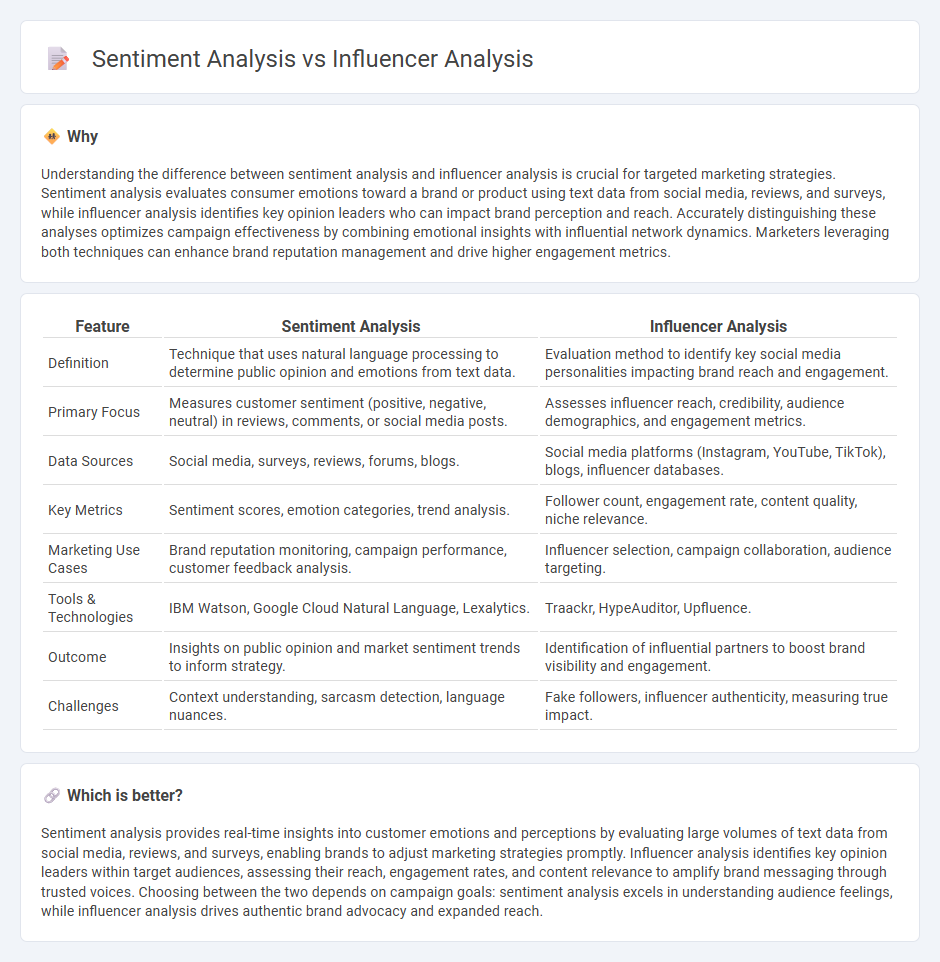
Sentiment analysis evaluates customer emotions and opinions expressed in online content, providing insights into brand perception and consumer behavior. Influencer analysis identifies key individuals who drive engagement and shape purchasing decisions through social media platforms. Explore how these powerful tools can optimize your marketing strategy and boost brand impact.
Why it is important
Understanding the difference between sentiment analysis and influencer analysis is crucial for targeted marketing strategies. Sentiment analysis evaluates consumer emotions toward a brand or product using text data from social media, reviews, and surveys, while influencer analysis identifies key opinion leaders who can impact brand perception and reach. Accurately distinguishing these analyses optimizes campaign effectiveness by combining emotional insights with influential network dynamics. Marketers leveraging both techniques can enhance brand reputation management and drive higher engagement metrics.
Comparison Table
| Feature | Sentiment Analysis | Influencer Analysis |
|---|---|---|
| Definition | Technique that uses natural language processing to determine public opinion and emotions from text data. | Evaluation method to identify key social media personalities impacting brand reach and engagement. |
| Primary Focus | Measures customer sentiment (positive, negative, neutral) in reviews, comments, or social media posts. | Assesses influencer reach, credibility, audience demographics, and engagement metrics. |
| Data Sources | Social media, surveys, reviews, forums, blogs. | Social media platforms (Instagram, YouTube, TikTok), blogs, influencer databases. |
| Key Metrics | Sentiment scores, emotion categories, trend analysis. | Follower count, engagement rate, content quality, niche relevance. |
| Marketing Use Cases | Brand reputation monitoring, campaign performance, customer feedback analysis. | Influencer selection, campaign collaboration, audience targeting. |
| Tools & Technologies | IBM Watson, Google Cloud Natural Language, Lexalytics. | Traackr, HypeAuditor, Upfluence. |
| Outcome | Insights on public opinion and market sentiment trends to inform strategy. | Identification of influential partners to boost brand visibility and engagement. |
| Challenges | Context understanding, sarcasm detection, language nuances. | Fake followers, influencer authenticity, measuring true impact. |
Which is better?
Sentiment analysis provides real-time insights into customer emotions and perceptions by evaluating large volumes of text data from social media, reviews, and surveys, enabling brands to adjust marketing strategies promptly. Influencer analysis identifies key opinion leaders within target audiences, assessing their reach, engagement rates, and content relevance to amplify brand messaging through trusted voices. Choosing between the two depends on campaign goals: sentiment analysis excels in understanding audience feelings, while influencer analysis drives authentic brand advocacy and expanded reach.
Connection
Sentiment analysis in marketing evaluates consumer emotions toward brands, products, or campaigns by analyzing online content and social media interactions. Influencer analysis identifies key opinion leaders whose sentiments and endorsements significantly impact audience perception and engagement. Combining these techniques enhances targeted marketing strategies by aligning brand messaging with influential voices and audience sentiment trends.
Key Terms
**Influencer Analysis:**
Influencer analysis identifies key individuals driving conversations and trends within specific niches by evaluating their reach, engagement, and audience demographics. It provides actionable insights into the impact and authority of influencers across social media platforms, aiding targeted marketing and brand collaboration strategies. Explore deeper to understand how influencer analysis can optimize your brand's influence and outreach.
Reach
Influencer analysis measures reach by identifying individuals with extensive networks and high audience engagement, which drives brand visibility and campaign effectiveness. Sentiment analysis evaluates the emotional tone within audience interactions but does not directly quantify reach size or scope. Explore how combining influencer analysis and sentiment analysis can optimize your marketing impact.
Engagement
Influencer analysis identifies key individuals driving engagement by measuring metrics such as follower growth, interaction rates, and reach across social platforms. Sentiment analysis evaluates audience emotions and opinions in content, tracking positive, negative, or neutral reactions to quantify engagement quality. Explore deeper insights to optimize your marketing strategy with advanced influencer and sentiment analysis techniques.
Source and External Links
Free Instagram Profile Analyzer & Influencer Analytics tool - Provides detailed influencer analysis metrics such as fake follower percentage, engagement rate, audience demographics, content quality, and audience growth correlation with conversions.
Influencer Analysis | Traackr | Influencer Marketing Platform - Offers deep influencer profile analytics including audience demographics, engagement stability, fraud detection, and alignment with brand values to help assess influencer impact and partnership suitability.
The 14 Best Influencer Analytics Tools for 2025 - MightyScout - Highlights tools that measure influencer marketing performance by tracking engagement rates, audience credibility (fake followers), and overall campaign metrics like reach and cost per engagement for optimized influencer selections.
 dowidth.com
dowidth.com